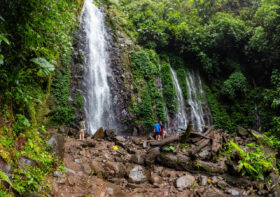Ways to save money on food in Costa Rica
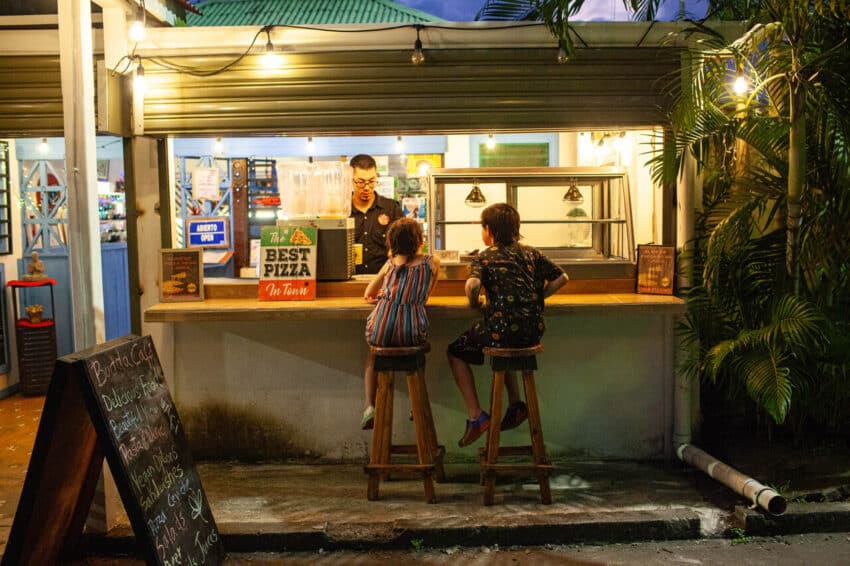
Costa Rica is expensive. This is one of the first and most frequent refrains we hear from people who have been here. And now that we have been here, we have to say that this is… somewhat true (unfortunately). Costa Rica prices are not outrageous. It is expensive compared to many of its Central and South American neighbours, but fairly comparable to the average North American restaurant. For our family of 4, every sit-down meal at a restaurant is at least $60 USD. Dinner can easily be over $100 USD.
Costa Rica cuisine is a tasty mix of latino-inspired and Mexican-inspired influences. There is lots of rice and beans, nachos and tacos, empanadas. You will find delicious seafood along the coast, and tons of fresh, tropical fruit. We are not foodies, but we enjoy good food and love experiencing local cuisine. Our kids, on a good day, will at least try almost anything.
If you, like us, want to enjoy what Costa Rica has to offer, but don’t want to completely break the bank, be sure to continue reading for our budget-friendly tips on eating in Costa Rica.
Plan to “dine out” once per day
This is a general rule we follow everywhere we travel. This is not only budget friendly (imagine how quickly $100 per meal racks up if you are eating at a restaurant 3 times a day!) but makes it so our itinerary does not revolve around food. As we mentioned, we are not foodies. Sometimes, a meal is more of an afterthought if we already have plans for the day. For the other meals/snacks, we might grab a bite from a street cart or bakery or some hole-in-the-wall joint, eat at the hotel, or even make ourselves if we have a kitchenette.
And we are talking about looking-up-recommendations, putting-on-clean-pants, sitting-down, drinks-and-maybe-dessert kind of meals. (Keep in mind that “water” is not something restaurants do. If you order a water, they will charge you for a bottle, so you might as well order a drink!) For us, a good view is a huge bonus. Eat to live, but also live to eat, amiright?
In Costa Rica, a few of our most memorable meals were:
- Buddha Cafe, Tortuguero – highly recommended in almost all the travel blogs and reviews we read on Tortuguero. This is a quite a touristy spot, a bit higher end than most of Tortuguero’s restaurants. It serves Italian and “clean-eating” options (salads and bowls). The restaurant sits right along the river, and the views at sunset are to *die* for.
- Jalapas Restuarant, Arenal – a little bit out of the way, but we were lucky because our hotel was right down the road. This boutique restaurant serves a higher-end version of Costa Rican delicacies. This was the best meal we had our entire trip. (It was cloudy, but on a clear day has a fantastic view.)
- El Avion, Manuel Antonio – open-air seafood and grill restaurant with *excellent* views of the Pacific ocean (I think we have a theme here :P). This restaurant is built around a defunct C-123 Fairchild cargo plane. The kids were able to explore the inside (converted into a bar), and found super cool.
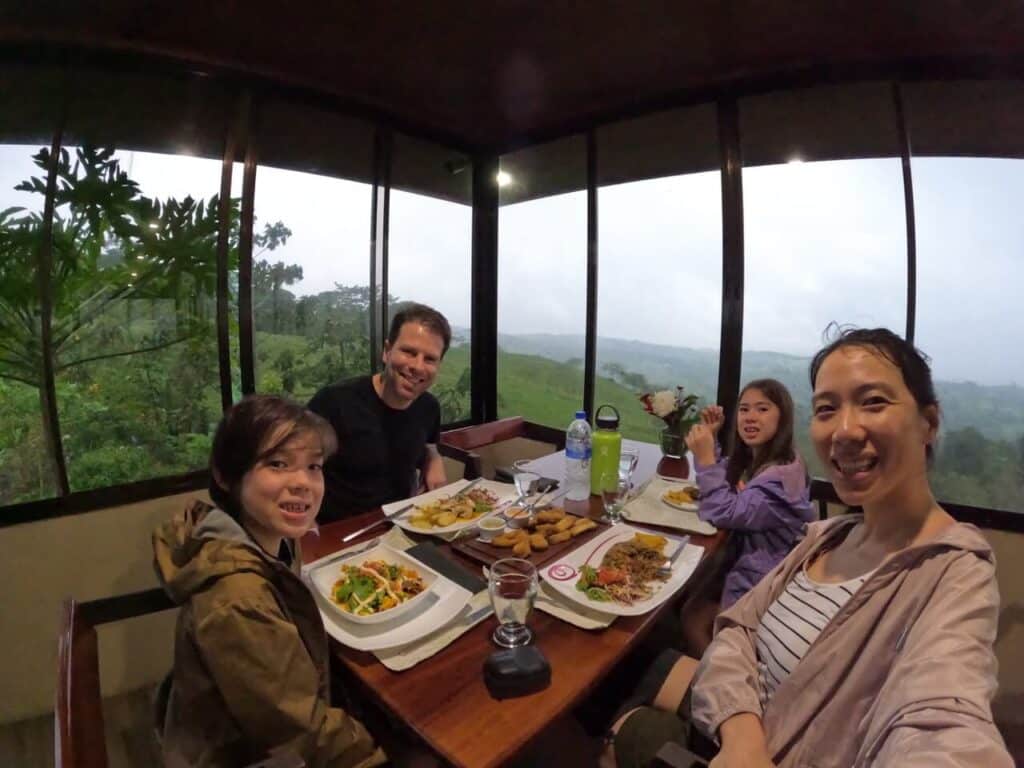
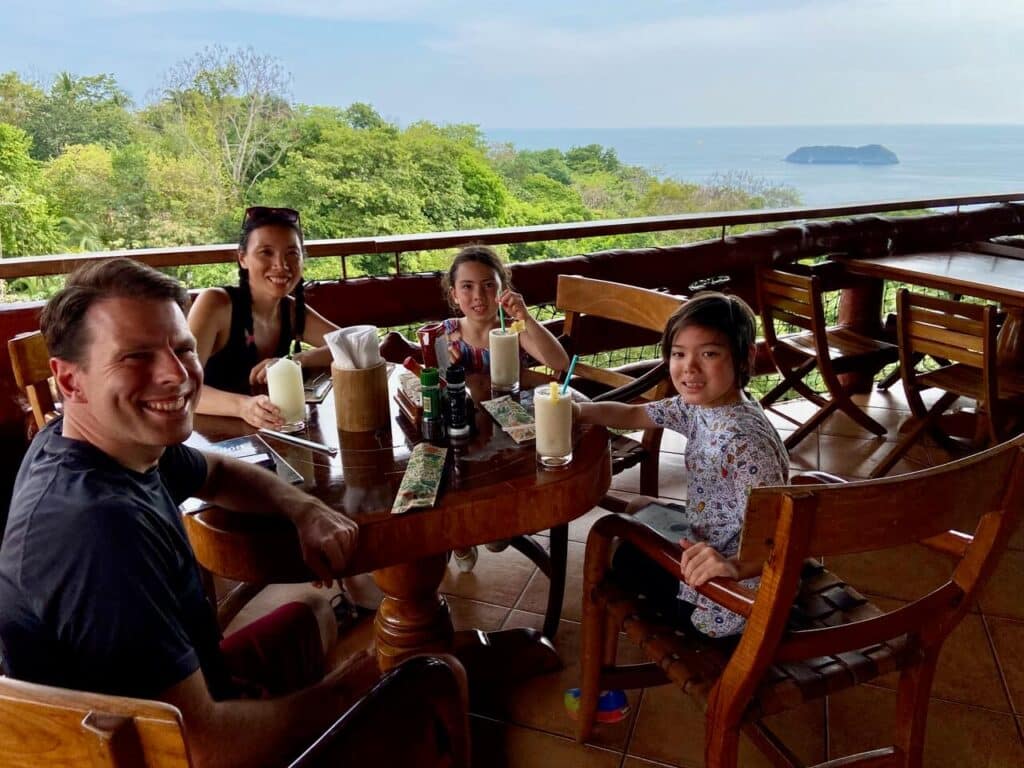
Eat meals at “sodas”
In Costa Rica, there are 2 types of places to eat – “sodas”, and “restaurants”. Restaurants are higher-end and more expensive. Sodas are more hole-in-the-wall places, mom-and-pop shops. They typically serve a mix of traditional Costa Rican food and western “finger” foods (think sandwiches and fries. In one case, the kids ordered fries mixed with cut up pieces of hot dog). Soda are typically cheaper, though not by a ton. (Eg. a meal at a soda costs around $40 USD for our family for 4.)
We had a few tasty breakfasts and dinners at various sodas across the country. “Casado” is a classic Costa Rican dish of rice and beans, plated with a meat or egg, and a vegetable or small salad. (I have to confess here that I only had this once or twice. A decade ago, I was working in Brazil while pregnant with Big S, and was extremely nauseated by strong smells. For years I could not even *think* about rice and beans without wanting to throw up!) Our kids usually chose to have a sandwich at these places, especially the comforting ham-and-cheese.
Soda are also a good spot to order a refreshing drink, as it is cheaper than restaurant drinks. Fresh juice and smoothies are always hits with the kids. Don’t forget to try to unofficial Costa Rican drink – the Copo! This is a shaved ice concoction smothered in condensed milk, fruit syrup, and milk powder.
The downside of eating at sodas is you are taking a risk. Even sodas that have reviews on Google or Tripadvisor are not always reliable. We ate at a soda in Monteverde where we found out the cook was *also* the travel agent booking tours! He served Daniel his burger with the plastic rind still on!

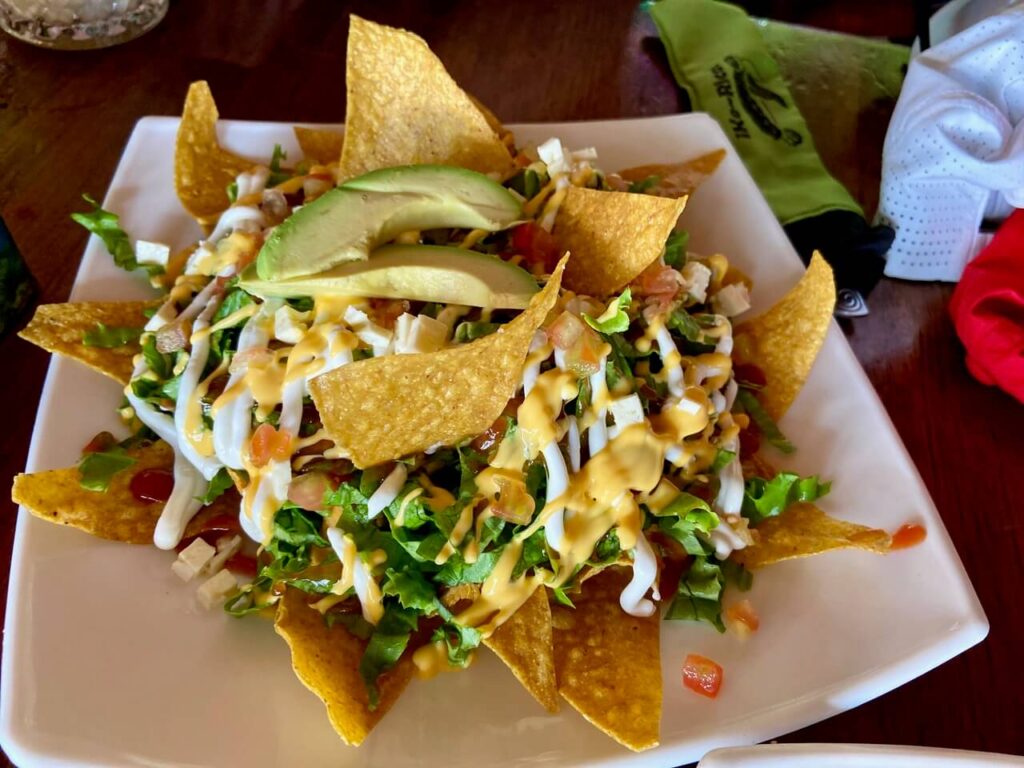
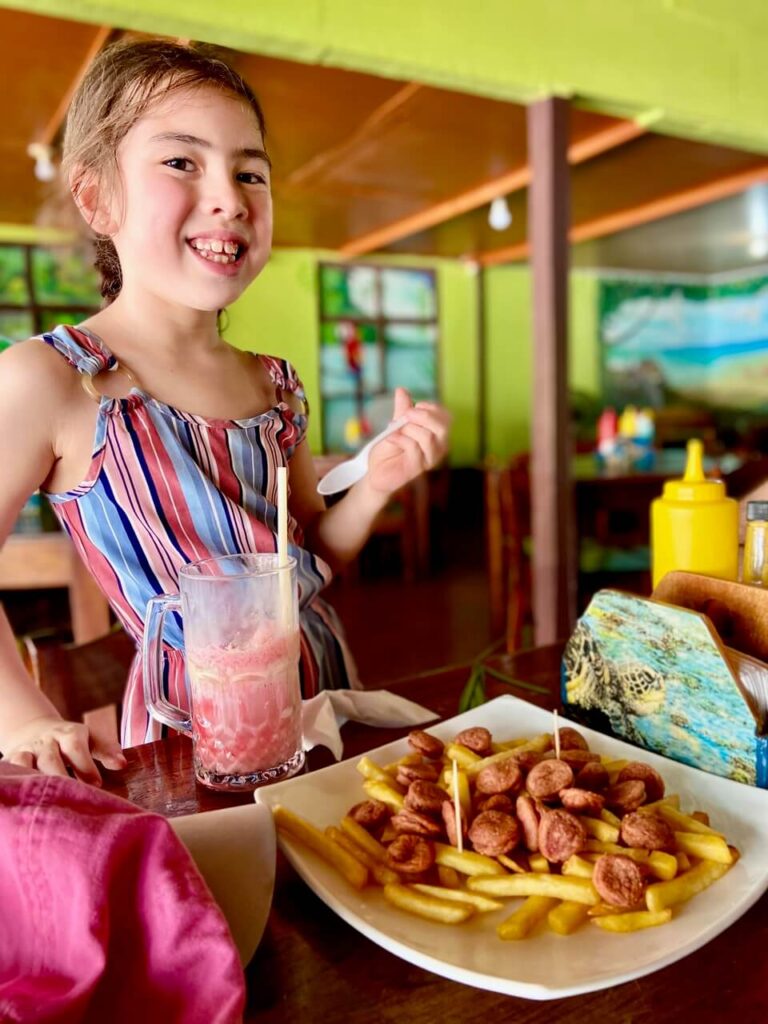
Order pizza
Is pizza not the world’s most ubiquitous food?
We frequently fall back on pizza when we travel. It’s quick, comforting, and the kids are guaranteed to eat it. You can find pizzerias everywhere. And a pizza meal is budget friendly. A large pizza costs maybe US $20 and is plenty for our family of 4.
In Tortuguero, the kids’ favourite meal was hands-down the pizza slice and tamarind juice combo right at the Buddha Cafe road-side counter. They got to experience Tortuguero coming to life at night, and spot geckos running across the ceiling. (Of course, the next night when we went to eat at the Buddha Cafe restaurant, the kids also proceeded to order… a pizza.)
Our favourite pizzeria was El Wagon in Manuel Antonio (right down the street from El Avion, by the same owners). This restaurant was a little on the expensive side for pizza, but we loved the ambience and the little squirrel monkeys that kept chasing each other in the nearby trees (and attempting to sneak food once in awhile). There is an old train coach right in the restaurant to explore, and the pizza is delicious.
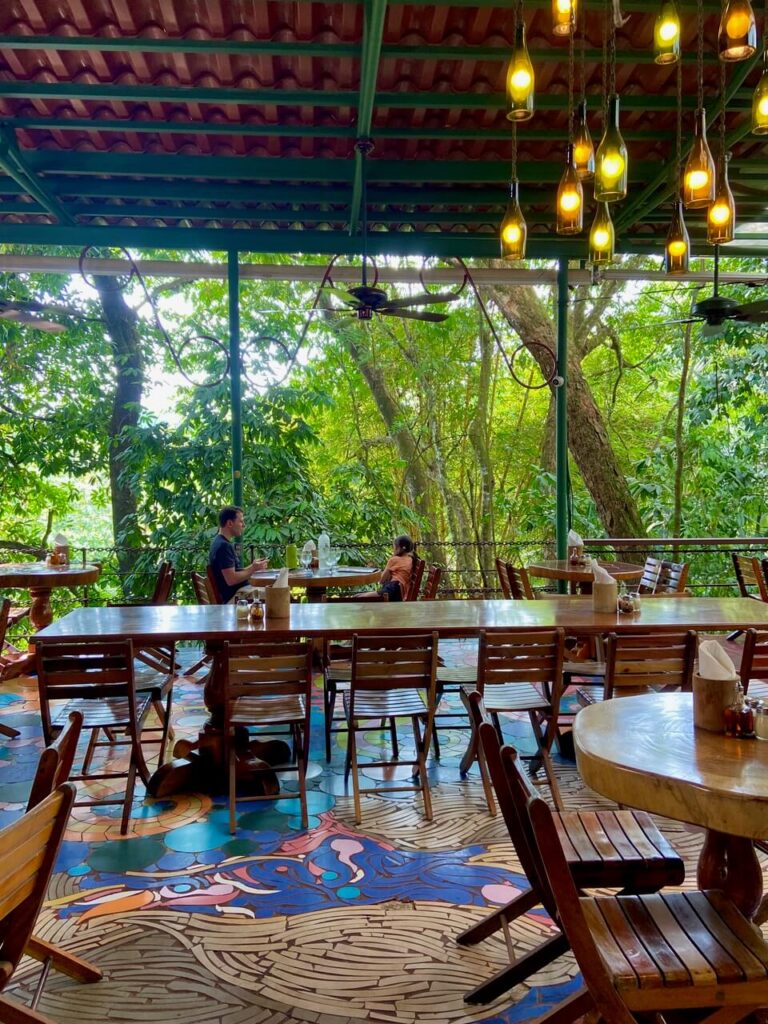
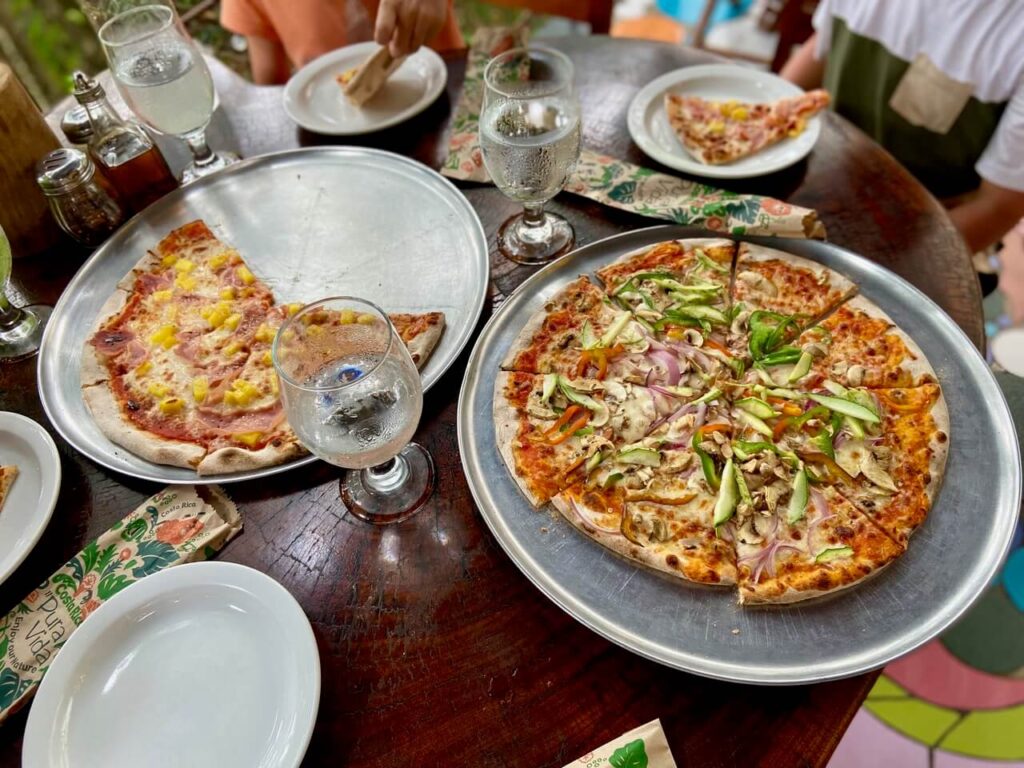
Pay in cash
Many restaurants in more touristy places will accept credit cards, but some restaurants do not. Even for the ones that do, be careful of being charged the 8% credit card fee many retailers will pass onto customers.
Pay in colones, and have a currency converter app handy
Downloading a currency converter app may seem like a strange food tip, but it may save you a ton of money in Costa Rica. Most places in Costa Rica will accept Costa Rican colones and US dollar, but the conversion is not always kosher. If the price is listed in colones, it is better to pay in colones. If you want to pay in US dollar, use your currency converter app to make sure you are being quoted a fair exchange rate.
This was sometimes a challenge for us, especially as we had to mentally approximate the value of everything in Canadian dollar.
Stay a few days at a (mid range) all-inclusive resort
While we would not recommend visiting Costa Rica just to stay at a resort, adding a few days at an all-inclusive to your itinerary is a good way to break up the trip. You don’t have to think about planning anything or getting anywhere, and food is taken care of. And when it comes to budget, we paid LESS for our 3 night all-inclusive stay at Barcelo Tambor than some of the other hotels we stayed at. While the food – at least at Barcelo Tambor – was nothing spectacular, I consider it a win when your biggest decision is what flavour of ice cream to have for dessert, and whether you should entertain your umpteenth cocktail of the day.
If you’re going to be enjoying the beach in Guanacaste or anywhere along the Pacific coast, definitely consider an all-inclusive. While Costa Rica boasts some high end resorts like Four Seasons, The Springs, and JW Marriott, you can find some pretty decent mid-range resorts such as Best Western Jaco, Occidental Tamarindo, and aforementioned Barcelo Tambor.
Book hotels that include breakfast
Hotels that provide breakfast are not only budget friendly (saving you the cost of a sit-down meal), but also incredibly convenient for Costa Rica, where many reserves and activities open early in the morning. A good breakfast spread could tide us over all the way to dinner. For lunch, we could easily get away with some snacks or a sharable platter (like nachos).
One of our most memorable breakfasts was during our AirBnb stay in Arenal. Our host’s grandmother made us a huge Costa Rican breakfast at her house, and made her own tamales for us.
At our hotel in Monteverde, we had animals coming to the doorstep every breakfast. This was probably the kids’ favourite part of the day!
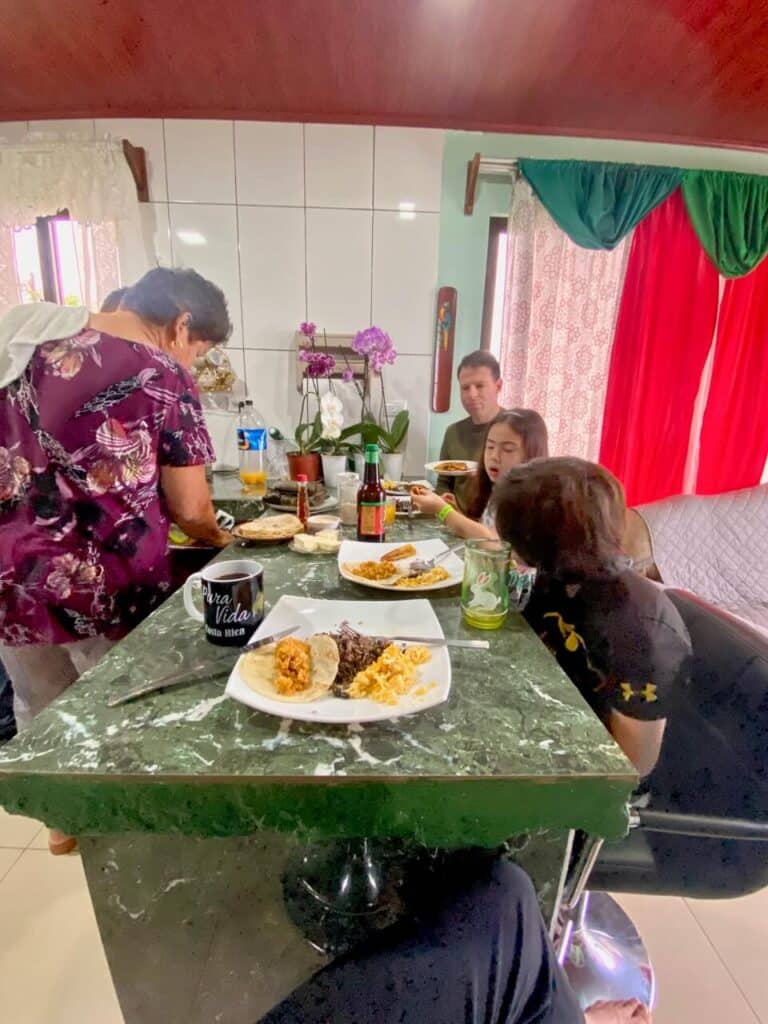

Book hotels with a kitchenette and shop for groceries
We did this all the time before we had kids. Hitting the grocery store was one of the first things we’d do when we arrived somewhere new. Not only does this save money, but it’s also a fun way to experience local life. Having kids makes this a little trickier, because it requires a little more planning, and sometimes it feels like our kids are hungry all. the. time.
Almost all the hotels we stayed at in Costa Rica (besides the all-inclusive) included a kitchen area with sink, microwave, fridge, and cookery/utensils. (This is different from most hotels in North America, which have a bar fridge and maybe microwave if you’re lucky.) For our first few days we were mostly bringing leftovers back to reheat, but eventually we got more comfortable working grocery shopping into our day. The kids particularly enjoyed picking out exotic fruits from markets and produce stands.
As for *what* to make, we usually keep things simple.
Breakfast:
- Bags of mini muffins, or other breakfast pastries like croissants or mini bagels
- Pre-made frozen breakfasts (like breakfast burritos)
- Toast
- Bananas, other fruit (mangos were a huge hit in Costa Rica)
- Avocado
- Milk or yogurt drinks for the kids
Lunch/dinner:
(Mostly lunch – if we were going to eat out, it was most likely for dinner.)
- Sandwiches – loaf of bread, deli meat, cheese slices
- Wraps – as above, but with wraps
- Fresh vegetables, mostly cucumbers (while water is clean in most parts of Costa Rica, we still prefer to stick with fruits and vegetables we can peel)
Fruits to try:
A category all on its own in Costa Rica!
- Mangos
- Coconut (Big S would literally *find* coconuts on the beach, then bring them back for Daniel to open)
- Oranges
- Guava
- Passion fruit
- Sour sop – we bought one in Monteverde but have to admit left most for the animals. The taste is sweet and a little milky, but nobody could get used to the texture (slimy)!
- Seasonal fruits: rambutan, starfruit
- Papaya and pineapple are popular here, but take into account if you have tools to prepare these and how to store leftovers!
Snacks
- Nuts and local “trail mix” (we found so many packets of different flavoured nuts)
- dried plantain chips (or yam chips, casava chips…)
- cookies – always fun to try local varieties!
- chocolate!
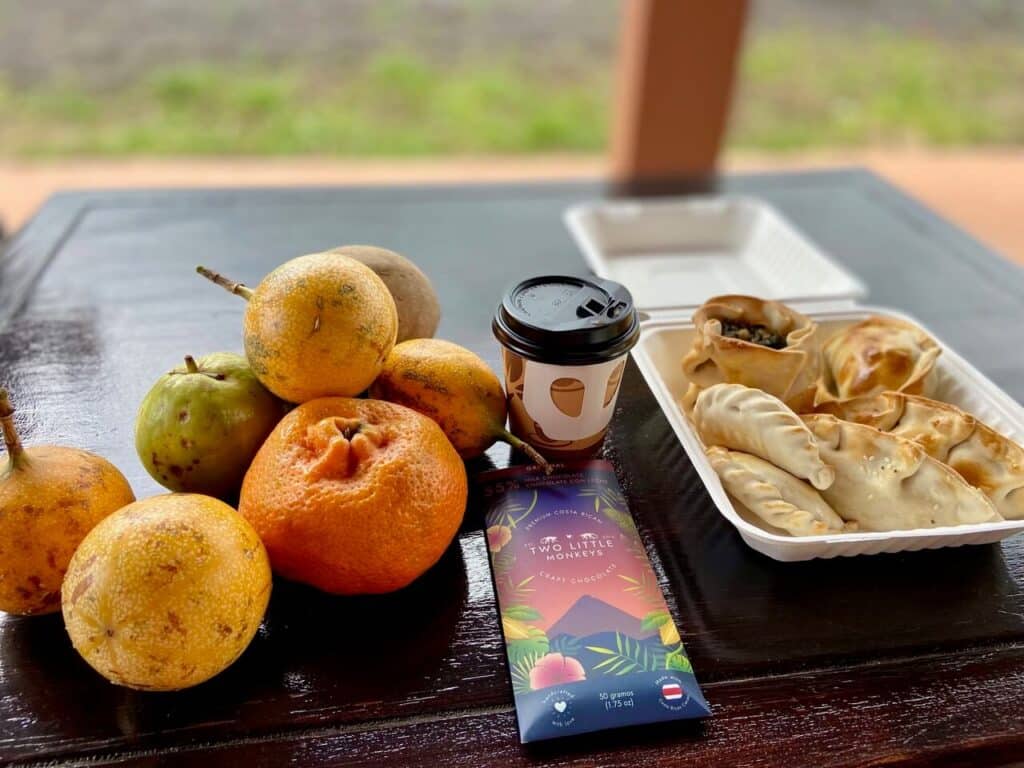
Bring snacks from home
Yes, you can buy local snacks, but we always bring some snacks from home when we travel. There will 100% be some point in your trip where the kids are grumpy and hungry and you just cannot get to food right away. This is especially true for travel days, or when you’re new to the region and haven’t gotten the lay of the land. We have a few staples we always bring in our suitcase:
- granola bars – we bring as many as we can stuff into the crannies of our carry-ons. These are easy to grab, don’t melt (don’t buy the ones covered in chocolate), filling, and are usually *more* expensive to buy at your destination
- Beef jerky
- Small packets of nuts – usually almonds
- Dried ginger or ginger candies – this is something we’ve only brought to Costa Rica, as we were warned some of the driving could cause motion sickness. It worked like a charm!
For more family-friendly Costa Rica tips and recommendations, be sure to check out our other articles!


